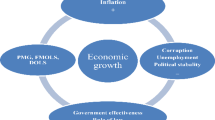Abstract
In this paper, we analyze the reactions of European economies to a fiscal policy strategy aiming at diminishing the public sector. Within the framework of the MSG3 model, a macroeconomic model of the world economy, we perform several simulation experiments to explore the effects of reducing government expenditures permanently in different phases of the business cycle. For this purpose, we combine the fiscal contraction with negative and positive, Euro Area-wide and global, supply and demand shocks. It turns out that adverse Keynesian effects on output and employment tend to be mostly weak and short-lived, whereas long-run effects on output and employment are favorable. Due to these long-run effects, the fiscal contraction policy raises welfare as measured by an asymmetric quadratic objective function. The size of these welfare effects depends on the initial situation in a non-trivial manner.
Similar content being viewed by others
References
Allsopp, Christopher; Artis, Michael J. (eds.). “EMU, Four Years On,” Oxford Review of Economic Policy, 19, 1, 2003.
Allsopp, Christopher; Vines, David (eds.). “Macroeconomic Policy after EMU,” Oxford Review of Economic Policy, 14, 3, 1998.
Buti, Marco; Sapir, André. Economic Policy in EMU, Oxford: Clarendon, 1998.
Buti, Marco; Sapir, André (eds.). EMU and Economic Policy in Europe, Cheltenham: Edward Elgar, 2003.
De Grauwe, Paul. Economics of Monetary Union, 5th ed., Oxford: Oxford University Press, 2003.
Eijffinger, Sylvester C. W.; de Haan, Jakob. European Monetary and Fiscal Policy, Oxford: Oxford University Press, 2000.
Hughes Hallett, Andrew; Mooslechner, Peter (eds.). “Challenges for Economic Policy Coordination within European Monetary Union,” Empirica, 26, 3, 1999.
McKibbin, Warwick J.; Sachs, Jeffrey D. Global Linkages, Washington, Brookings Institution, 1991.
McKibbin, Warwick J.; Wilcoxen, Peter J. “The Theoretical and Empirical Structure of the G-Cubed Model,” Economic Modelling, 16, 1998, pp. 123–48.
Neck, Reinhard (ed.). “The Macroeconomics of EMU”, Open Economies Review, 13, 4, 2002.
Neck, Reinhard; Holzmann, Robert (eds.). “European Monetary and Fiscal Policies: Myths and Facts,” Empirica, 29, 3, 2002.
Author information
Authors and Affiliations
Additional information
Financial support from the Jubiläumsfonds of the Austrian National Bank (project no. 9152) and from the Ludwig Boltzmann Institute for Economic Analyses is gratefully acknowledged. The views expressed in this paper need not be those of the Austrian National Bank. Thanks are due to Harald Stieber for helpful comments.
Rights and permissions
About this article
Cite this article
Haber, G., Neck, R. & McKibbin, W.J. Less Government—More Wealth? On the Macroeconomics of a Smaller Public Sector in Europe. Int Adv Econ Res 12, 1–15 (2006). https://doi.org/10.1007/s11294-006-6121-3
Received:
Accepted:
Published:
Issue Date:
DOI: https://doi.org/10.1007/s11294-006-6121-3




